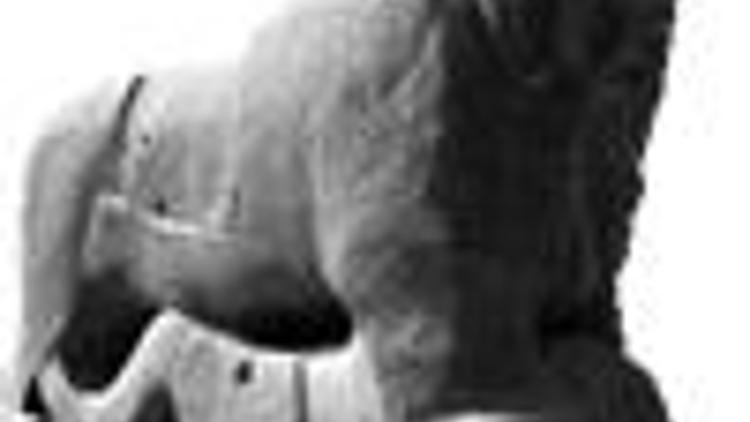Iraq: Can ancient Babylon be rescued?
Güncelleme Tarihi:

BABYLON - The United States, which turned Babylon into a military base, says the looting would have been worse but for the troops' presence. The US also says it will help rehabilitate Babylon, funding an effort by the World Monuments Fund and Iraq's State Board of Antiquities and Heritage

It was one of the world's first, greatest cities Ğ a place where astronomers mapped the stars millennia ago and kings created an early code of law and planted what became known as the Hanging Gardens of Babylon.
Yet little remains of the ancient capital, as seen by The Associated Press during a trip to Babylon last month on one of the few permits issued by Iraq's government since the 2003 U.S.-led invasion. The site has the aura of a theme park touched by the ambition of dictator Saddam Hussein and the opportunism of looters: Modern walkways run beside crumbling old walls, a reconstructed Greek theater and a palace built for Saddam atop an artificial hill. Now, for the first time, global institutions led by the U.N. are thoroughly documenting the damage and how to fix it. A UNESCO report due out early next year will cite Saddam's construction but focus, at the Iraqi government's request, on damage done by U.S. forces from April to September 2003, and the Polish troops deployed there for more than a year afterward.
The U.S., which turned Babylon into a military base, says the looting would have been worse but for the troops' presence. The U.S. also says it will help rehabilitate Babylon, funding an effort by the World Monuments Fund and Iraq's State Board of Antiquities and Heritage, but has yet to release precise funding figures. Archaeologists hope the effort will lead someday to new digging to follow up on the excavations done by a German team in the early 1900s. "The site is tremendously important," said Gaetano Palumbo of the New York City-based World Monuments Fund. Yet in its present state, Babylon is "hardly understandable, as a place where so much happened in history." Past excavations focused on the monuments such as temples. But domestic quarters remain largely unexplored, Palumbo said, and new methods could reveal new facts or reinterpret findings from excavations done 100 years ago. For decades, Babylon has been virtually off-limits to the world whose culture it helped create. First came Saddam's attempt to create a major tourist attraction aimed at glorifying his own image, which led to shoddy reconstruction of ancient sites and construction of restaurants and other facilities in the 1980s. Most international experts stayed away because of the regime's reputation, the eight-year war with ıran and U.N. sanctions. Next, Babylon suffered in the chaotic days after Saddam's downfall in 2003, at roughly the same time that Baghdad's national museum was looted. Archaeologists say looters took museum items at Babylon, mostly plaster replicas, and burned excavation reports and other studies. Then came the occupation by U.S. and Polish troops in 2003 and 2004. Heavy vehicles and machinery pounded on ancient brick and on sand rich with pottery and other fragments. Military forces built a helipad, carved out parking areas and trenches, destroyed part of an ancient brick road called the Processional Way and filled bags with sand containing bones and pottery pieces, according to Iraqi officials and a British Museum report done several years ago. Even as Babylon was damaged, there has been no extensive, large-scale archaeological work here in nearly a century. There is no trace of the Hanging Gardens, said to have been built for the homesick wife of King Nebuchadnezzar II, or the tower believed to have inspired the Bible's tale of Babel. King Hammurabi's code of law, inscribed on a giant stone slab almost 4,000 years ago, has long sat in Paris' Louvre. The city's symbol Ğ the original Gate of Ishtar named for a Babylonian goddess and built by Nebuchadnezzar Ğ is at Berlin's Pergamon museum. At the site, near the Euphrates River about 60 miles (100 kilometers) south of Baghdad, journalists saw a gaudy reconstruction of the Ishtar gate built during Saddam's time, plus part of the original gate's foundations. The foundations hold unglazed depictions of a dragon, some appearing damaged. A spell of relative peace in Iraq is giving Babylon a second chance. However, tremendous challenges remain. There is still little security or infrastructure at Babylon or at most of Iraq's 12,000 other archaeological sites. Looting across Iraq appears to have eased, at least temporarily, because of stricter international controls and reports of saturation in the illegal market in Iraqi artifacts, according to archaeologists. But the country has only 1,500 police who guard the sites to prevent looting. Many areas remain too dangerous for visitors or scholars to travel, and some fear heavier violence could resume, making any work a target. Although Iraq's government is involved in the project, a top aide to Iraq's prime minister said the government has more pressing priorities. And it could take years for Babylon to get on UNESCO's list of World Heritage sites.

